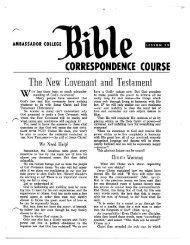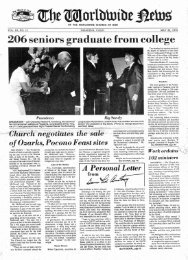Crucifixion Was Not on Friday (1968)_b.pdf - Herbert W. Armstrong
Crucifixion Was Not on Friday (1968)_b.pdf - Herbert W. Armstrong
Crucifixion Was Not on Friday (1968)_b.pdf - Herbert W. Armstrong
You also want an ePaper? Increase the reach of your titles
YUMPU automatically turns print PDFs into web optimized ePapers that Google loves.
The <str<strong>on</strong>g>Crucifixi<strong>on</strong></str<strong>on</strong>g> <str<strong>on</strong>g>Was</str<strong>on</strong>g> <str<strong>on</strong>g>Not</str<strong>on</strong>g> <strong>on</strong> <strong>Friday</strong> 45<br />
ing the postp<strong>on</strong>ement of the leap year. This postp<strong>on</strong>ement<br />
in 142 A.D. was necessary or else the Passover would have<br />
occurred too late in the year and would not have been observed<br />
in its proper seas<strong>on</strong>. Even the Seventh-Day Adventist Commentary<br />
recognizes this change in the cycles, though it is unacquainted<br />
with the year in which it occurred. Thus in the<br />
days of Jesus the years which had 13 m<strong>on</strong>ths were as follows:<br />
2, 5, 7, 10, 13, 16, 18. Since 31 A.D. was the 10th year of a<br />
cycle, it was a leap year with 13 m<strong>on</strong>ths. That means that the<br />
new mo<strong>on</strong> which we located <strong>on</strong> September 5 was the new mo<strong>on</strong><br />
of the sixth m<strong>on</strong>th, not the seventh.<br />
Now what do we do? We have to add the length of another<br />
m<strong>on</strong>th (29d 12h 44m 3lhs) to our figures thus:<br />
Sept. 5<br />
+29d<br />
11h<br />
+12h<br />
8m<br />
+44m<br />
13lhs<br />
+3lhs<br />
Oct. 4<br />
23h<br />
52m<br />
So the new mo<strong>on</strong> which determined the seventh m<strong>on</strong>th<br />
in 31 A.D. occurred, according to the Julian Calendar, <strong>on</strong><br />
October 4, 23 hours, 52 minutes and 16% sec<strong>on</strong>ds after midnight.<br />
On Which Day of the Week?<br />
It is very simple to find <strong>on</strong> which day of the week this<br />
was so l<strong>on</strong>g ago. There were 1900 years between 31 A.D. and<br />
1931. Since each year averaged 365~ days, just multiply this<br />
figure by 1900! And the answer is 693,975 days between Saturday,<br />
August 30 in 1931 and August 30 in 31 A.D.<br />
On which day of the week was this? Divide 693,975 days<br />
by 7 and you will have the number of weeks that elapsed! The<br />
answer is 99,139 weeks and 2 days. That means that August<br />
30 in 31 A.D. was exactly 99,139 weeks and 2 days earlier than<br />
in 1931. It was thus two days earlier in the week! It was Saturday<br />
in 1931. August 30 was therefore Thursday in 31 A.D.<br />
This would make October 4, the exact time of the c<strong>on</strong>juncti<strong>on</strong><br />
of the seventh new mo<strong>on</strong>, a THURSDAY!

















